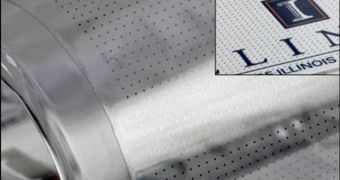Researchers at the University of Illinois in Urbana-Champaign (UI) have recently developed a new kind of very tiny, inorganic, bright, light-emitting diodes (LEDs), which they hope to be able to use in practical applications such as thin and foldable video screens. Wall-sized displays could also become possible with the new technology, they believe. In the future, we could have portable displays with us everywhere we go that can be rolled up and stored in a small amount of space when not in use.
The scientists say that the new inorganic LEDs are just as thin as other varieties, but that they are brighter and, as such, suitable for a lot more applications. These diodes appeared from an effort to combine the low manufacturing cost of conventional, carbon-based organic LEDs with the brightness and efficiency of gallium arsenide- and gallium nitride-based organic ones. “We wanted to see if we could use inorganic LEDs in ways that exploit some of the processing advantages of organic LEDs,” UI materials scientist John Rogers explains.
The expert is also the coauthor of a new study detailing the diodes, which appears in the August 21st issue of the respected journal Science. The team that developed the thin, organic LEDs also included experts from research institutions in China and Singapore. The main challenge this effort faced was devising a way to grow, shape and handle vast amounts of inorganic diodes, without having to rely on robots for the job. While the machines are efficient at doing this, the task becomes too cumbersome when thousands or hundreds of thousands of tiny devices are involved, ScienceNow reports.
The new production method allows for the bright LEDs to be applied to a number of flexible substrates, such as glass, plastic or rubber, which means that the array of applications in which these diodes could potentially be used is very large. In terms of costs, a square centimeter of the inorganic LEDs is still more expensive than their organic counterparts, but the team says that their brightness allows for fewer of them to be set on the same surface, which essentially implies that costs are roughly equivalent, in the end.

 14 DAY TRIAL //
14 DAY TRIAL //